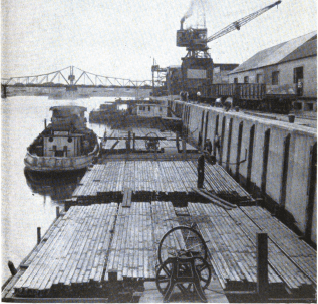
 The following description is from 1941.
The following description is from 1941.
The city of Troy is situated on the Hudson River, approximately 151 miles north of the Battery, New York City. It is the eastern and southern termini of the Erie and Champlain branches, respectively, of the New York State Barge Canal System.
The harbor [in 1941] embraces the entire waterfront of the city of Troy from the southerly limits of the city to the Federal lock and dam, the controlling channel depths being 11 feet with widths varying from 170 to 400 feet up to the Delaware & Hudson Railroad bridge, and from 90 to 300 feet to the Lock.
Access to the port from the Atlantic Ocean and points south is through the deep-water channels of New York Harbor and the Hudson River. Access to the harbor at Troy from the Great Lakes and Canada is through the canal and the pool above the lock and dam at Troy. From Waterford to Troy the controlling depth is 14 feet for a width ranging from 170 to 200 feet.
Information on tides and tidal currents at localities on the Hudson River is given here. Restricted width of the river and the character of the bottom are
not suitable for safe anchorage of vessels. Vessels usually lie at the wharves during lay-over or loading and unloading periods.
Electrical current for lighting and power for all industrial and commercial purposes is furnished by the Niagara Hudson Power Corporation and distributed by the New York Power & Light Corporation. Current is not supplied to vessels at the wharves in Troy except by special arrangement.
The water supply of Troy is derived from reservoirs having a total storage capacity of 13,570,000,000 gallons, and the quality is of a high degree of softness, suitable for drinking and boiler purposes.
The comparatively low meter-rate for industrial purposes of 5 cents per 1,000 gallons, or approximately 128 cubic feet, is due in part to the fact that the water system of the city is fed entirely by gravity, no pumping units being required.
There are no facilities for supplying bunker fuel oil or coal to vessels at Troy. The nearest source of supply is at Albany, NY.
Piers, Wharves, and Docks
There are nine wharves or terminals in use at Troy, with a total berthing space of 2,383 linear feet, having depths of water alongside ranging from 14 to 9 feet at lowest low water.
Two of the facilities with a berthage of 60 feet are used for handling petroleum products; three with a total berthage of 650 feet are used by industrial plants, one with 960 feet of berthing is a New York State Barge Canal terminal, one having 250 feet of berthing is used for handling building materials, and two with a combined berthage of 465 feet are used for handling scrap metals.
The publicly owned barge-canal terminal extending from the foot of Liberty Street to the foot of Adams Street is equipped with a five-ton steam-operated traveling gantry crane with a reach of 36 feet. The industrial terminals are those of the Ford Motor Co., the Republic Steel Corporation, and the Hudson Valley Fuel Corporation.
Although the city of Troy has improved about 14 miles of the waterfront by the construction of a concrete bulkhead, the greater portion of it is not used in connection with water transportation.
The plant of the Ludlow Valve Co., situated south of the barge-canal terminal, has a concrete bulkhead 1,080 feet long, which is not used for shipping purposes, since the raw materials and finished products are received and shipped by rail.
The United States Arsenal at Watervliet, on the west bank of the river opposite the Ludlow Valve Co., has an excellent masonry bulkhead 755 feet long, which is not used in connection with water transportation.
The water front at Troy is protected by the city fire department and has an efficient fire-alarm system. In general, hydrants are maintained in the streets adjacent to the water-front facilities.
The following is a description of the piers, wharves, and docks at Troy which are in use:
1. Hudson Valley Fuel Corporation pier. This pier is owned by the Hudson Valley Fuel Corporation and is a narrow open pile structure, situated about 750 feet north of the Troy-Menands Bridge.
It is 65 feet long, 6 feet wide, and carries four pipe lines for the receipt of acid from barges and for the delivery of tar and bensol to vessels. Mooring dolphins at the end of the pier provide berthing space of 100 feet. The available depth of water at the end of the pier at lowest low water is 14 feet.
2. Republic Steel Corporation wharf. The wharf owned and operated by the Republic Steel Corporation is situated about 2,700 feet north of the Troy-Menands Bridge.
It consists of a former railroad-car float moored to the timber crib bulkhead at the bank, and is used for the shipment of pig iron. By special arrangement between the owners and the Hudson Valley Fuel Corporation, it is also used by the latter for shipment of coke.
The floating wharf is 250 feet long, and the depth of water alongside is 12 feet at lowest low water. A track of the plant railroad extends along the top of the bank in rear of the wharf.
Coke is dumped from cars and transferred across the wharf to barges by an electric belt conveyor, which has a rated capacity of 60 tons per hour.
A 25-ton electric revolving crane which has a reach of 55 feet and is equipped with magnets capable of lifting one ton, for handling pig iron from car to barge is located on the wharf.
3. New York State Barge Canal terminal. This terminal is situated at the foot of Washington Street and is operated by the Division of Canals and Waterways of the New York State Department of Public Works. It consists of a concrete bulkhead 960 feet long, with 12 feet of water alongside at lowest low water.
Although designed primarily for handling canal freight, the terminal can be used for handling other cargo. Three surface tracks, 2 of which are on the apron, have a total length of 1,962 feet and are connected with the tracks of the Delaware & Hudson, the New York Central, and the Boston & Maine Railroads [which utilized by the Fitchburg Railroad].
There is a one-story wooden transit shed and terminal warehouse, with a floor area of 3,800 square feet. Handling equipment consists of a five-ton steam-operated traveling gantry crane with 36-foot reach, equipped with a 42-inch lifting magnet.
4. Trojan Scrap Iron Corporation wharf. The terminal located between the foot of Division and Liberty Streets is owned by J.L. Rogers and the Trojan Scrap Iron Corporation, and is operated by the latter for the shipment of scrap iron.
The wharf consists of a 340-foot concrete bulkhead, which provides the same amount of berthing in 10 feet of water at lowest low water. Scrap metal is handled by gasoline tractor and truck cranes.
The tractor crane is capable of lifting 14 tons, has a 45-foot reach and is equipped with a 45-inch magnet. The truck crane has a reach of 30 feet, is equipped with a 30-inch magnet, and is capable of lifting 5 tons. A two-car railroad siding enters the yard in the rear of the wharf.
5. Symansky Iron & Steel Co. wharf. This wharf is a concrete bulkhead located between the foot of Ferry Street and Congress Street Bridge. The property is owned by the Murray Estate and is operated by the Symansky Iron & Steel Co. as a shipping point for scrap metals.
The bulkhead has a water frontage of 125 feet, and the same amount of berthing space in nine feet of water. Handling of scrap iron, etc., is accomplished by means of a revolving truck crane equipped with a 36-inch magnet. The crane is capable of lifting five tons and has a reach of 40 feet.
6. Standard Oil Co. wharf. The Standard Oil Co. of New York maintains a 15 by 25-foot floating wharf moored at piles at the southerly end of Starbuck Island, with pipe lines extending from it to storage tanks on the Watervliet side of the river.
A flexible pipe section connects the float with the pipe line on shore. The depth of water at the wharf is about 9 feet at lowest low water.
7. Hartol Terminal Corporation wharf. A floating wharf 35 feet long and 20 feet wide, similar to the one of the Standard Oil Co., is maintained by the Hartol Terminal Corporation on Starbuck Island, some distance north of the lower end.
It has pipe lines extending to 15 storage tanks on the island. A flexible pipe section connects with the shore pipe line. The depth of water at the wharf is about nine feet at lowest low water.
8. Rickerson Supply Co. wharf. The property occupied by the wharf of the Rickerson Supply Co. is owned by various interests. The wharf is a concrete bulkhead, 250 feet long, with 11 feet of water alongside at lowest low water, and is used for the handling of building and road materials.
The mechanical handling facilities include a 10-ton tractor crane having a 50-foot reach equipped with clamshell buckets, and a portable belt bucket elevator capable of loading 30 cubic yards of sand or gravel to trucks per hour. A 50-yard and two 20-yard sand and stone hoppers are also available.
9. Ford Motor Co. wharf. This wharf, situated on Green Island, on the west side of the river above the dam, forms part of the Ford Motor Co. plant at that place. It is a concrete bulkhead 300 feet long having 13 feet of water alongside at normal pool level.
A 25-ton, electrically-operated traveling gantry crane, with a 38-foot reach, spans a railroad siding on the edge of the wharf connecting with the Delaware & Hudson Railroad. There are two surface tracks having a total length of 590 feet on the wharf.
The Empire Terminal Warehouse Co., Inc., operates two buildings about one-third mile from the water front which provide a total of approximately 45,000 square feet of space for the storage of general merchandise.
The Troy Storage Warehouse Co. has three buildings about the same distance from the water front which provide 20,222 square feet of space for storing general merchandise, the usual commodities handled being flour, metals, beer, sugar, canned goods, and refractory products.
This essay was excerpted from Port and Terminal Facilities at the Ports on the Upper Hudson River, 1941 (U.S. Government Printing Office, 1942) and annotated by John Warren.
Photo: Unloading steel rails from Buffalo at the Barge Canal Terminal at Troy for transshipment to New York, 1941.








Recent Comments